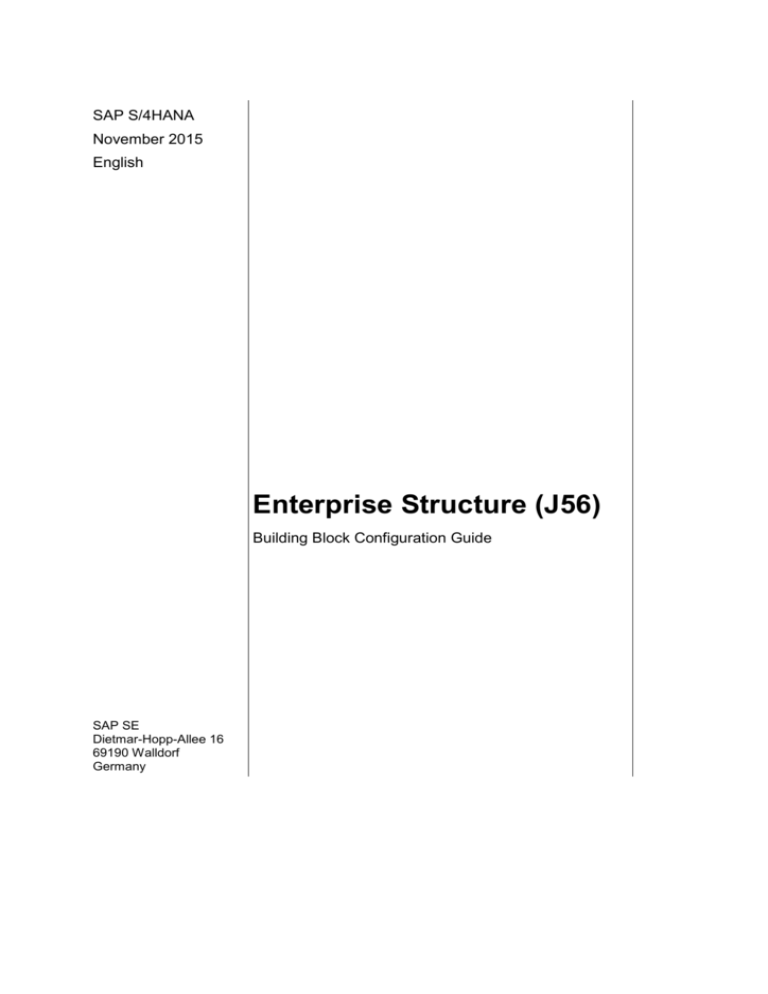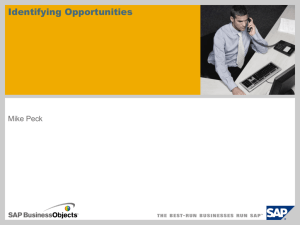
SAP S/4HANA
November 2015
English
Enterprise Structure (J56)
Building Block Configuration Guide
SAP SE
Dietmar-Hopp-Allee 16
69190 Walldorf
Germany
SAP Best Practices
Enterprise Structure (J56): Configuration Guide
Copyright
© 2015 SAP SE or an SAP affiliate company. All rights reserved.
No part of this publication may be reproduced or transmitted in any form or for any purpose without the
express permission of SAP SE or an SAP affiliate company.
SAP and other SAP products and services mentioned herein as well as their respective logos are
trademarks or registered trademarks of SAP SE (or an SAP affiliate company) in Germany and other
countries. Please see http://global.sap.com/corporate-en/legal/copyright/index.epx#trademark for
additional trademark information and notices.
Some software products marketed by SAP SE and its distributors contain proprietary software
components of other software vendors.
National product specifications may vary.
These materials are provided by SAP SE or an SAP affiliate company for informational purposes only,
without representation or warranty of any kind, and SAP SE or its affiliated companies shall not be liable
for errors or omissions with respect to the materials. The only warranties for SAP SE or SAP affiliate
company products and services are those that are set forth in the express warranty statements
accompanying such products and services, if any. Nothing herein should be construed as constituting
an additional warranty.
In particular, SAP SE or its affiliated companies have no obligation to pursue any course of business
outlined in this document or any related presentation, or to develop or release any functionality
mentioned therein. This document, or any related presentation, and SAP SE’s or its affiliated
companies’ strategy and possible future developments, products, and/or platform directions and
functionality are all subject to change and may be changed by SAP SE or its affiliated companies at any
time for any reason without notice. The information in this document is not a commitment, promise, or
legal obligation to deliver any material, code, or functionality. All forward-looking statements are subject
to various risks and uncertainties that could cause actual results to differ materially from expectations.
Readers are cautioned not to place undue reliance on these forward-looking statements, which speak
only as of their dates, and they should not be relied upon in making purchasing decisions.
© SAP SE
Page 2 of 9
SAP Best Practices
Enterprise Structure (J56): Configuration Guide
Icons
Icon
Meaning
Caution
Example
Note
Recommendation
Syntax
Typographic Conventions
Type Style Description
Example text Words or characters that appear on the screen. These include field names,
screen titles, buttons as well as menu names, paths and options.
Cross-references to other documentation.
Example
text
Emphasized words or phrases in body text, titles of graphics and tables.
EXAMPLE
TEXT
Names of elements in the system. These include report names, program
names, transaction codes, table names, and individual key words of a
programming language, when surrounded by body text, for example, SELECT
and INCLUDE.
Example
text
Screen output. This includes file and directory names and their paths,
messages, source code, names of variables and parameters as well as names
of installation, upgrade and database tools.
EXAMPLE TEXT Keys
on the keyboard, for example, function keys (such as F2) or the ENTER
key.
Example
text
Exact user entry. These are words or characters that you enter in the system
exactly as they appear in the documentation.
<Example
text>
Variable user entry. Pointed brackets indicate that you replace these words
and characters with appropriate entries.
© SAP SE
Page 3 of 9
SAP Best Practices
Enterprise Structure (J56): Configuration Guide
Content
Enterprise Structure ................................................................................................................... 5
1
Purpose .............................................................................................................................. 5
2
Preparation ......................................................................................................................... 5
2.1
3
Prerequisites ............................................................................................................ 5
Configuration ...................................................................................................................... 5
3.1
Creating Controlling Area ......................................................................................... 5
3.2
Creating Credit Control Area .................................................................................... 6
3.3
Defining Loading Groups ......................................................................................... 6
3.4
Defining Transportation Groups ............................................................................... 7
3.5
Defining Shipping Conditions ................................................................................... 7
3.6
Defining Storage Conditions .................................................................................... 8
3.7
Create Purchasing Groups....................................................................................... 8
© SAP SE
Page 4 of 9
SAP Best Practices
Enterprise Structure (J56): Configuration Guide
Enterprise Structure
1 Purpose
The purpose of this document is to describe the general configuration steps required to
manually set up the configuration within the system landscape that has already been installed
using the corresponding installation or configuration guides for installation.
This document supplements the existing Customizing documentation in the Implementation
Guide (IMG) and provides additional information where required.
2 Preparation
2.1 Prerequisites
Before you start installing this scenario, you must install the prerequisite building blocks. For
more information, see the Building Block Prerequisites Matrix.
3 Configuration
The following section describes the complete settings for this building block. These settings
can be divided into three main groups:
Prerequisite settings that have to be checked and which were delivered by SAP (as part
of the standard delivery)
The term Check refers to these prerequisite settings.
Settings defined by the customer (in the customer namespace and customer-specific):
The system uses automation to request individual customer settings during the
personalization process. These settings can be initial or reused from existing SAP ERP
layers and are indicated in the text by <your value>.
Additional settings that must be made, covered either by automation or manual
configuration (in the customer namespace).
The term Create refers to these additional settings in the text.
3.1 Creating Controlling Area
Use
In this step, you define your controlling area. The controlling area is an organizational unit in
Accounting used to subdivide the business organization from a cost accounting standpoint.
Procedure
1. Access the activity using one of the following navigation options:
IMG Menu
Enterprise Structure Definition Controlling Maintain
Controlling Area
Transaction
Code
OX06
© SAP SE
Page 5 of 9
SAP Best Practices
Enterprise Structure (J56): Configuration Guide
2. In the Choose Activity dialog box, double-click Maintain Controlling Area.
3. On the Change View “Basic data”: Overview screen, choose New Entries.
4. Make the following entries:
Controlling
Area
Name
CoCd->CO
Area
Currency
Type
Currency
Chart
of
Accts
FY
Variant
A000
Controlling
area A000
Crosscompanycode cost
accounting
30
USD
YCOA
K4
3. Save your entries.
3.2 Creating Credit Control Area
Use
In this step, you define your credit control areas. The credit control area is an organizational
unit that specifies and checks a credit limit for customers.
A credit control area can include one or more company codes. You cannot assign
a company code to more than one control area. Within a credit control area, the
credit limits must be specified in the same currency.
Procedure
1. Access the activity using one of the following navigation options:
IMG Menu
Enterprise Structure Definition Financial Accounting Define
Credit Control Area
Transaction
Code
OB45
2. On the Change View “Credit Control Areas”: Overview screen, choose New Entries.
3. Make the following entries:
Credit Control Area
Description
Currency
Update
FY Variant
A000
Credit control area A000
USD
000012
K4
4. Save your entries.
3.3 Defining Loading Groups
Use
In this step you define the loading groups. You enter the loading groups defined here in the
material master record for the sales data for each plant.
Procedure
1. Access the activity using one of the following navigation options:
© SAP SE
Page 6 of 9
SAP Best Practices
Enterprise Structure (J56): Configuration Guide
IMG Menu
Logistics Execution Shipping Basic Shipping Functions
Shipping Point and Goods Receiving Point Determination Define
Loading Groups
Transaction
Code
OVSX
2. On the “Routes: Loading Groups”: Overview screen, make the following entries.
LGrp
Description
0001
Crane
0002
Forklift
0003
Manual
3. Save your entries.
3.4 Defining Transportation Groups
Use
In this step you define the transportation groups. You specify the transportation groups
defined here in sales/plant data of the material master record. The transportation group is
copied into the delivery item.
Procedure
1. Access the activity using one of the following navigation options:
IMG Menu
Sales and Distribution Basic Functions Routes Route
Determination Define Transportation Groups
Transaction
Code
OVSY
2. On the Change View “Deliver Scheduling: Transportation Groups”: Overview screen,
make the following assignments.
Trans. grp
Description
0001
On pallets
0002
In liquid form
0003
Container
0004
Parcel
0005
Bulk Product
3. Save your entries.
3.5 Defining Shipping Conditions
Use
In this step you enter the shipping conditions defined in the customer master record in the
sales data for each sales area. The SAP system copies the shipping condition into the sales
document header.
Procedure
© SAP SE
Page 7 of 9
SAP Best Practices
Enterprise Structure (J56): Configuration Guide
1. Access the activity using one of the following navigation options:
IMG Menu
Logistics Execution Shipping Basic Shipping Functions
Shipping Point and Goods Receiving Point Determination Define
Shipping Conditions
Transaction
Code
OVSF
2. On the Change View “Shipping Conditions”: Overview screen, make the following
assignments.
SC
Description
01
Standard
02
Pick-up
03
Immediately
04
Transport Service
RE
Returns
3. Save your entries.
3.6 Defining Storage Conditions
Use
In this activity you define the storage conditions.
Procedure
1. Access the activity using one of the following navigation options:
IMG Menu
Logistics Execution Shipping Picking Determine Picking
Location Define storage conditions
Transaction
Code
SPRO
2. On the Change View “Storage conditions”: Overview screen, enter the following:
SC
Description
10
storage condition10
20
storage condition 20
3. Save your entries.
3.7 Create Purchasing Groups
Use
In this activity, you define the purchasing groups. We deliver three entries to be maintained
via a Self-service UI.
Procedure
1. Access the transaction using one of the following navigation options:
Transaction
© SAP SE
SPRO
Page 8 of 9
SAP Best Practices
Enterprise Structure (J56): Configuration Guide
Code
IMG Menu
SAP Customizing Implementation Guide Materials Management
Purchasing Create Purchasing Groups
2. On the Change View: 'Purchasing Groups': Overview screen, choose New Entries.
3. On the New Entries: Overview of Added Entries screen, make the following settings:
Field Name
Entry Value
Purchasing Group
001
Desc. Pur. Grp
Group 001
Tel.No. Pur Grp.
7708409421
Fax number
7708409000
Telephone
331
Extension
1
E-Mail Address
a
4. Press Enter.
5. Repeat step 3 and 4 for the next two entries:
Field Name
Entry Value
Purchasing Group
002
Desc. Pur. Grp
Group 002
Tel.No. Pur Grp.
7708409421
Fax number
7708409000
Telephone
331
Extension
1
E-Mail Address
a
Field Name
Entry Value
Purchasing Group
003
Desc. Pur. Grp
Group 003
Tel.No. Pur Grp.
7708409421
Fax number
7708409000
Telephone
331
Extension
1
E-Mail Address
a
6. Save your entries.
Result
You created three purchasing groups.
© SAP SE
Page 9 of 9








